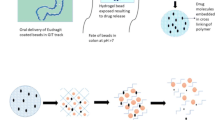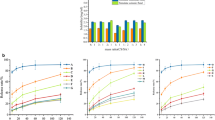Abstract
Enteric coating of hydrogel beads is an effective approach to resolve the drug entrapment problem reported in previous studies. In the present study, microencapsulation of drug in hydrogel beads with extrusion-dripping technique was used for the improvement of the drug entrapment efficiency. Calcium chloride dehydrate was used as a cross-linking agent and oil-in-oil solution of eudragit S-100 was used as coating material while diclofenac sodium was used as a model drug. Optical microscopy, scanning electron microscopy, weight, elemental, and size variation of prepared hydrogels beads were analyzed and found within the acceptable limits. The drug loading and release studies of the coated beads were evaluated. Retardation of the model drug in gastric and intestinal pH environment until 8 h was observed which made the prepared hydrogels more targeted and colon-specific. In acidic pH 1.2, negligible percentage release was observed, whereas at pH 7.4, 98% diclofenac sodium was estimated after 8 h. In vitro release, kinetic studies proved that concentration-dependent release behavior of diclofenac sodium followed Fick’s law of diffusion in coated form, while non-Fickian behavior was observed in uncoated beads. Prepared hydrogel beads may be used as a promising tool for sustained release of drug targeting colon.





Similar content being viewed by others
References
Paharia A, Yadav AK, Rai G, Jain SK, Pancholi SS, Agrawal GP (2007) Eudragit-coated pectin microspheres of 5-fluorouracil for colon targeting. AAPS PharmSciTech 8(1):E87–E93
Wang Q, Xie X, Zhang X, Zhang J, Wang A (2010) Preparation and swelling properties of pH-sensitive composite hydrogel beads based on chitosan-g-poly (acrylic acid)/vermiculite and sodium alginate for diclofenac controlled release. Int J Biol Macromol 46(3):356–362
Chan E-S, Lee B-B, Ravindra P, Poncelet D (2009) Prediction models for shape and size of ca-alginate macrobeads produced through extrusion–dripping method. J Colloid Interface Sci 338(1):63–72
Dai YN, Li P, Zhang JP, Wang AQ, Wei Q (2008) Swelling characteristics and drug delivery properties of nifedipine-loaded pH sensitive alginate–chitosan hydrogel beads. J Biomed Mater Res B Appl Biomater 86(2):493–500
Arvapalli S, Nandini P, Sharma R, Sharma J (2019) Design, characterization and evaluation of hydrogel beads of dalfampridine using synthetic polymers
Kusuma KNM, Swathi B, Ramkanth S, Kusuma S (2014) Formulation and evaluation of Losartan hydrogel beads. Int J Pharm Drug Anal 2:788–795
Rai G, Yadav AK, Jain NK, Agrawal GP (2016) Eudragit-coated dextran microspheres of 5-fluorouracil for site-specific delivery to colon. Drug Deliv 23(1):328–337
Agüero L, Zaldivar-Silva D, Peña L, Dias ML (2017) Alginate microparticles as oral colon drug delivery device: a review. Carbohyd Polym 168:32–43
Pervez S, Nawaz MA, Aman A, Qayyum S, Nawaz F, Qader SAU (2018) Agarose hydrogel beads: an effective approach to improve the catalytic activity, stability and reusability of fungal amyloglucosidase of GH15 family. Catal Lett 148(9):2643–2653
Gombotz WR, Wee SF (2012) Protein release from alginate matrices. Adv Drug Deliv Rev 64:194–205
Nochos A, Douroumis D, Bouropoulos N (2008) In vitro release of bovine serum albumin from alginate/HPMC hydrogel beads. Carbohyd Polym 74(3):451–457
Bajpai S, Sharma S (2004) Investigation of swelling/degradation behaviour of alginate beads crosslinked with Ca2+ and Ba2+ ions. React Funct Polym 59(2):129–140
Buss A, Locs J Effects of calcium and alginate concentration on the calcium-deficient hydroxyapatite hydrogel bead formation. In: Key engineering materials, 2017. Trans Tech Publications, pp 187–191
Giri TK, Dey B, Maity S (2018) Preparation and characterization of nanoemulsome entrapped in enteric coated hydrogel beads for the controlled delivery of capsaicin to the colon. Curr Drug Ther 13(1):98–105
Obeidat WM, Price JC (2006) Preparation and evaluation of Eudragit S 100 microspheres as pH-sensitive release preparations for piroxicam and theophylline using the emulsion-solvent evaporation method. J Microencapsul 23(2):195–202
Chawla A, Sharma P, Pawar P (2012) Eudragit S-100 coated sodium alginate microspheres of naproxen sodium: formulation, optimization and in vitro evaluation/Alginatne mikrosfere naproksen natrija obložene Eudragitom S-100: Priprava, optimizacija i in vitro vrednovanje. Acta Pharmaceutica 62(4):529–545
Deshmukh R, Harwansh RK, Paul SD, Shukla R (2020) Controlled release of sulfasalazine loaded amidated pectin microparticles through Eudragit S 100 coated capsule for management of inflammatory bowel disease. J Drug Deliv Sci Technol 55:101495
Altman R, Bosch B, Brune K, Patrignani P, Young C (2015) Advances in NSAID development: evolution of diclofenac products using pharmaceutical technology. Drugs 75(8):859
Lorenzo-Lamosa M, Remunan-Lopez C, Vila-Jato J, Alonso M (1998) Design of microencapsulated chitosan microspheres for colonic drug delivery. J Control Release 52(1):109–118
Park TG, Hoffman AS (1992) Preparation of large, uniform size temperature-sensitive hydrogel beads. J Polym Sci, Part A: Polym Chem 30(3):505–507
Ahn J-S, Choi H-K, Chun M-K, Ryu J-M, Jung J-H, Kim Y-U, Cho C-S (2002) Release of triamcinolone acetonide from mucoadhesive polymer composed of chitosan and poly (acrylic acid) in vitro. Biomaterials 23(6):1411–1416
Korsmeyer RW, Gurny R, Doelker E, Buri P, Peppas NA (1983) Mechanisms of solute release from porous hydrophilic polymers. Int J Pharm 15(1):25–35
Murata Y, Miyamoto E, Kawashima S (1996) Additive effect of chondroitin sulfate and chitosan on drug release from calcium-induced alginate gel beads. J Controlled Release 38(2–3):101–108
Merakchi A, Bettayeb S, Drouiche N, Adour L, Lounici H (2019) Cross-linking and modification of sodium alginate biopolymer for dye removal in aqueous solution. Polym Bull 76(7):3535–3554
Lee BB, Ravindra P, Chan ES (2013) Size and shape of calcium alginate beads produced by extrusion dripping. Chem Eng Technol 36(10):1627–1642
Yoo MK, Choi HK, Kim TH, Choi YJ, Akaike T, Shirakawa M, Cho CS (2005) Drug release from xyloglucan beads coated with Eudragit for oral drug delivery. Arch Pharmacal Res 28(6):736
Pasparakis G, Bouropoulos N (2006) Swelling studies and in vitro release of verapamil from calcium alginate and calcium alginate–chitosan beads. Int J Pharm 323(1):34–42
Weng L, Tessier SN, Swei A, Stott SL, Toner M (2017) Controlled ice nucleation using freeze-dried Pseudomonas syringae encapsulated in alginate beads. Cryobiology 75:1–6
Hua S, Ma H, Li X, Yang H, Wang A (2010) pH-sensitive sodium alginate/poly (vinyl alcohol) hydrogel beads prepared by combined Ca2+ crosslinking and freeze-thawing cycles for controlled release of diclofenac sodium. Int J Biol Macromol 46(5):517–523
Thakral NK, Ray AR, Majumdar DK (2010) Eudragit S-100 entrapped chitosan microspheres of valdecoxib for colon cancer. J Mater Sci Mater Med 21(9):2691–2699
Palomo M, Ballesteros M, Frutos P (1999) Analysis of diclofenac sodium and derivatives. J Pharm Biomed Anal 21(1):83–94
Chiew CSC, Yeoh HK, Pasbakhsh P, Poh PE, Tey BT, Chan ES (2016) Stability and reusability of alginate-based adsorbents for repetitive lead (II) removal. Polym Degrad Stab 123:146–154
Shivakumar H, Desai B, Deshmukh G (2008) Design and optimization of diclofenac sodium controlled release solid dispersions by response surface methodology. Indian J Pharm Sci 70(1):22
Mehta R, Chawla A, Sharma P, Pawar P (2013) Formulation and in vitro evaluation of Eudragit S-100 coated naproxen matrix tablets for colon-targeted drug delivery system. J Adv Pharm Technol Res 4(1):31
Elnashar MM, Yassin MA, Moneim A, El-Fetouh A, Abdel Bary EM (2010) Surprising performance of alginate beads for the release of low-molecular-weight drugs. J Appl Polym Sci 116(5):3021–3026
Dainty A, Goulding K, Robinson P, Simpkins I, Trevan M (1986) Stability of alginate-immobilized algal cells. Biotechnol Bioeng 28(2):210–216
Rodrı́guez M, Vila-Jato JL, Torres D (1998) Design of a new multiparticulate system for potential site-specific and controlled drug delivery to the colonic region. J Control Release 55(1):67–77
Khan M, Sridhar B, Srinatha A (2010) Development and evaluation of pH-dependent micro beads for colon targeting. Indian J Pharm Sci 72(1):18
Fernandez-Hervas M, Holgado M, Fini A, Fell J (1998) In vitro evaluation of alginate beads of a diclofenac salt. Int J Pharm 163(1):23–34
Author information
Authors and Affiliations
Corresponding authors
Additional information
Publisher's Note
Springer Nature remains neutral with regard to jurisdictional claims in published maps and institutional affiliations.
Rights and permissions
About this article
Cite this article
Rehman, S., Ranjha, N.M., Raza, M.R. et al. Enteric-coated Ca-alginate hydrogel beads: a promising tool for colon targeted drug delivery system. Polym. Bull. 78, 5103–5117 (2021). https://doi.org/10.1007/s00289-020-03359-1
Received:
Revised:
Accepted:
Published:
Issue Date:
DOI: https://doi.org/10.1007/s00289-020-03359-1




